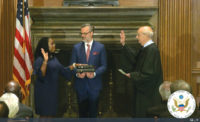The U.S. Supreme Court says it will consider a request by several states, and power and industry groups, to block implementation of the U.S. Environmental Protection Agency’s “good neighbor” requirements under the 2015 national ambient air quality standard for smog, until ongoing legal challenges to requirements are resolved. The states are petitioners are hoping for clarity in an extraordinarily complex series of cases and requirements.
The high court said Dec. 20 it will hear oral arguments in February for four different applications by the states and groups to block EPA from implementing the plan that was finalized earlier this year. It requires 23 states to develop their own plans to reduce emissions of nitrogen oxides (NOx) and particulate matter, the main sources of smog, that negatively impact air quality in other states.
But EPA disapproved 19 of the plans, attempting to require those states to adhere to its own federal plan to reduce emissions. Several states subsequently filed legal challenges in federal court. The petitioners to the Supreme Court say they believe their legal challenges in the Washington, D.C., federal appeals court and other federal courts will be successful and therefore should not be subject to EPA’s requirements.
According to documents filed with the court, the litigants contend that EPA’s imposition of a federal plan is “arbitrary and capricious” and that it “inflicts irreparable economic injuries on the states and others every day it remains in effect.” Moreover, because of ongoing legal challenges working their way through the courts, only 11 states out of the 23 now are implementing either EPA’s or their own plans.
In the most recent request filed Oct. 26, U.S. Steel Corp. called the EPA plan "legally and factually unsound and likely to be vacated in its entirety. It was built on the premise that the agency could impose [the plan on every state] that contributes significantly to downwind ozone concentrations. This was a foundation of sand that has now washed away."
EPA has said the good neighbor plan will not only save lives, it will reduce NOx emissions from the 23 “significantly contributing” upwind states by 70,000 tons during the 2026 ozone season between May 1 and Sept. 30, compared to a business-as-usual scenario.
The petitioners include West Virginia, Ohio, and Indiana and also trade groups affiliated with the oil and gas sector, including the American Petroleum Institute and the Midwest Ozone Group. Additionally, groups representing industrial emission sources, including the Portland Cement Association, pulp and paper mills, and the American Iron and Steel Institute, are involved with ongoing legal challenges and are parties to the case before the Supreme Court.
Good Neighbor Requirements
Under the Clean Air Act’s good neighbor requirements, states must develop plans to ensure controls are in place to reduce emissions that negatively impact air quality in downwind states. The requirements typically apply to any air quality standard that EPA develops.
The Good Neighbor Plan for ozone required 23 states, largely but not solely in the eastern U.S., to develop state implementation plans to reduce emissions of pollutants that contribute to smog in other states. This is done in coordination with industry to add controls at power plants and industrial sources, such as cement kilns and steel mills.
States that fail to enact a plan that fails to meet minimum emissions reductions within two years of the enactment of the air quality standards forfeit their ability to enact their plan, which then triggers EPA to require them to comply with its federal plan.
According to Louis Baer, senior director and counsel, government affairs at the Portland Cement Association, EPA’s “blanket disapproval” of 19 state plans, coupled with stays imposed by various appellate courts have created a “legal patchwork, a quagmire.”
“Basically, you’re either in a state ... kind of in a holding pattern, or you have to begin complying,” he says.
"It is encouraging that the court has agreed to consider the state and trade group requests, Baer adds. “I think the Supreme Court is going to be concerned about this patchwork and the procedural process, and how we got there.”






Post a comment to this article
Report Abusive Comment